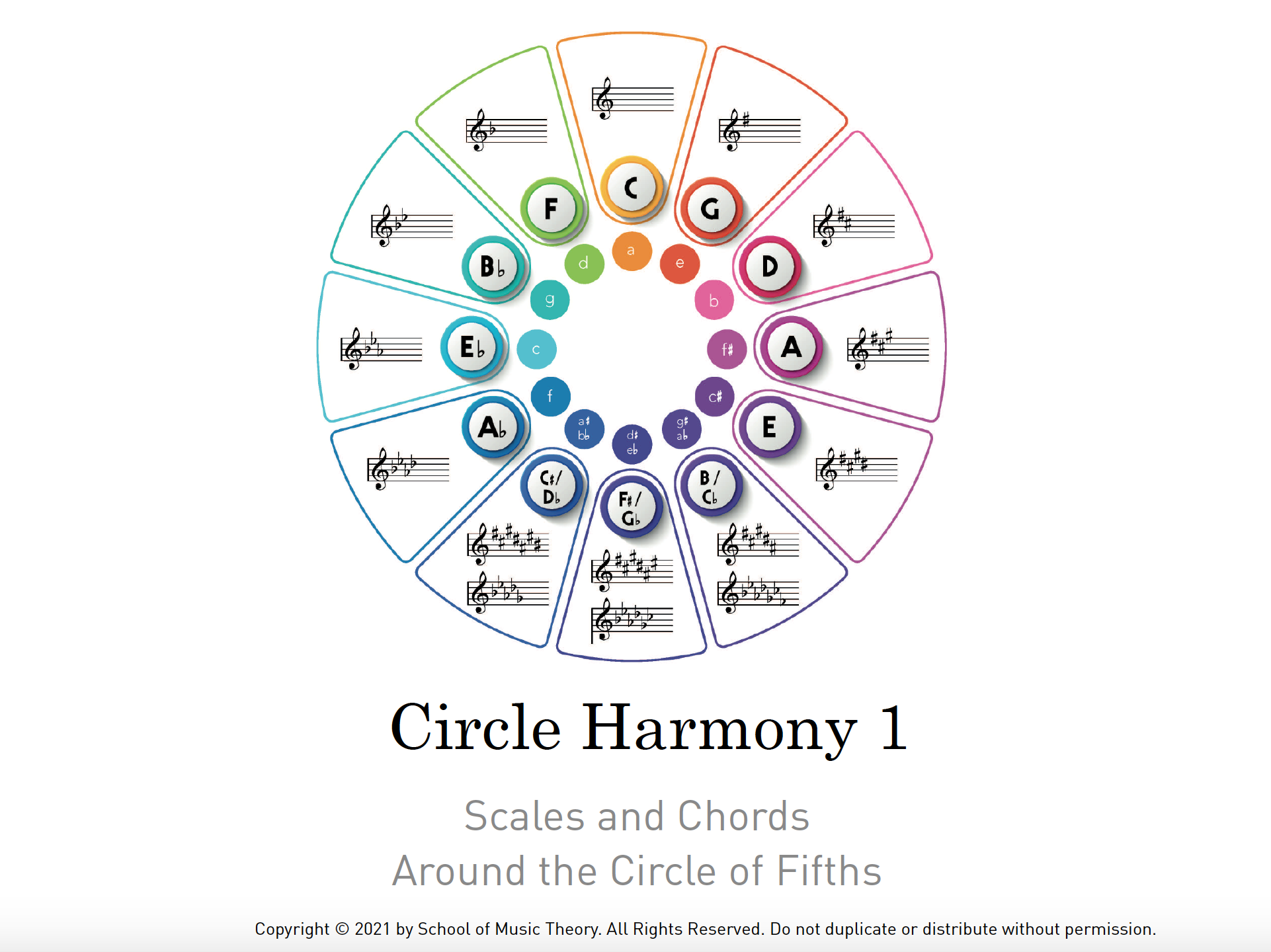Circle Harmony is an applied music theory curriculum designed to introduce core concepts of major and minor scale construction, key relations and basic harmony around the circle of fifths. The approach focuses on exploring scales, fifth relations and primary chords through playing as well as writing. Lesson slides are designed in a clear and visually attractive way and can be used as teaching guides or given to students as handouts.
The Circle Harmony Bundle includes:
Circle Harmony 1
The curriculum for Circle Harmony 1 is downloadable as a 127-page ebook and is divided into three parts:
- Part 1: The Circle of Fifths - tetrachords, building major scales, fifth relations, sharp key signatures, flat key signatures, relative minor scales
- Part 2: Primary Chords - scale degrees 1 - 4 - 5, tonic - subdominant - dominant, I - IV - V(7) chords, i - iv - V(7) chords, playing primary chord cadences in all positions, transposition of primary chords, harmonisation and creative discovery activities, quick study activities
- Part 3: Scales & Chords Around the Circle of Fifths
Parts 1 and 2 present lessons and activities around scale building, key relations, chord building and Roman numeral analysis. Part 3 includes checklists for applying these concepts at the instrument at 3 different difficulty levels. This approach can be used to seed theoretical understanding at the earliest stages of learning through to developing a full understanding of tonal diatonic harmony.
Circle Harmony 2
The curriculum for Circle Harmony 2 is downloadable as a 77-page ebook and is divided into three parts:
- Part 1: Natural Minor - relative minor scales around the circle of fifths, primary chords from the natural minor, the subtonic
- Part 2: Harmonic Minor - harmonic minor scales around the circle of fifths, primary chords from the harmonic minor, the leading note, the function of V7, minor key signatures
- Part 3: Melodic Minor - melodic minor scales around the circle of fifths, primary chords from the melodic minor and their style differences
Circle Harmony 1 introduces ideas of relative minor and harmonic minor. Circle Harmony 2 goes into greater detail about natural, harmonic and melodic minors - their reasons for existing and the expanded palette of chords that they offer.
Circle Harmony Workbook
The Circle Harmony Workbook is designed to accompany Circle Harmony 1 and 2. It is intended to provide plenty of practice writing scales and chords covered in the curriculum.
The Circle Harmony Workboook is downloadable as a 192-page ebook and is divided into eight parts:
- Part 1: Sharp Key Signatures - Major & Minor Scales
- Part 2: Flat Key Signatures - Major & Minor Scales
- Part 3: Circle of Fifths
- Part 4: Grade 1 Scales and Chords
- Part 5: Grade 2 Scales and Chords
- Part 6: Grade 3 Scales and Chords
- Part 7: Grade 4 Scales and Chords
- Part 8: Grade 5 Scales and Chords
- Appendix: Sharp Key Signatures - Major & Minor Scales and Their Key Signatures
- Appendix: Flat Key Signatures - Major & Minor Scales and Their Key Signatures
Parts 1 and 2 work systematically around the circle of fifths. Part 3 provides two blank circle of fifths for students to fill in. Parts 4 through 8 drill the scales and chords required for each grade (grades 1-5) of the ABRSM syllabus. The Appendices include all major and minor scales and their key signatures.
Circle Harmony is designed to provide the groundwork for more formal music theory studies up to and including grade 5 of the various exam boards. This resource can be used for teaching from an Elementary to a Late Intermediate level.
The Circle Harmony curriculum and workbooks are created by the School of Music Theory. You can read more about the School of Music Theory by going to https://www.schoolofmusictheory.com/.























